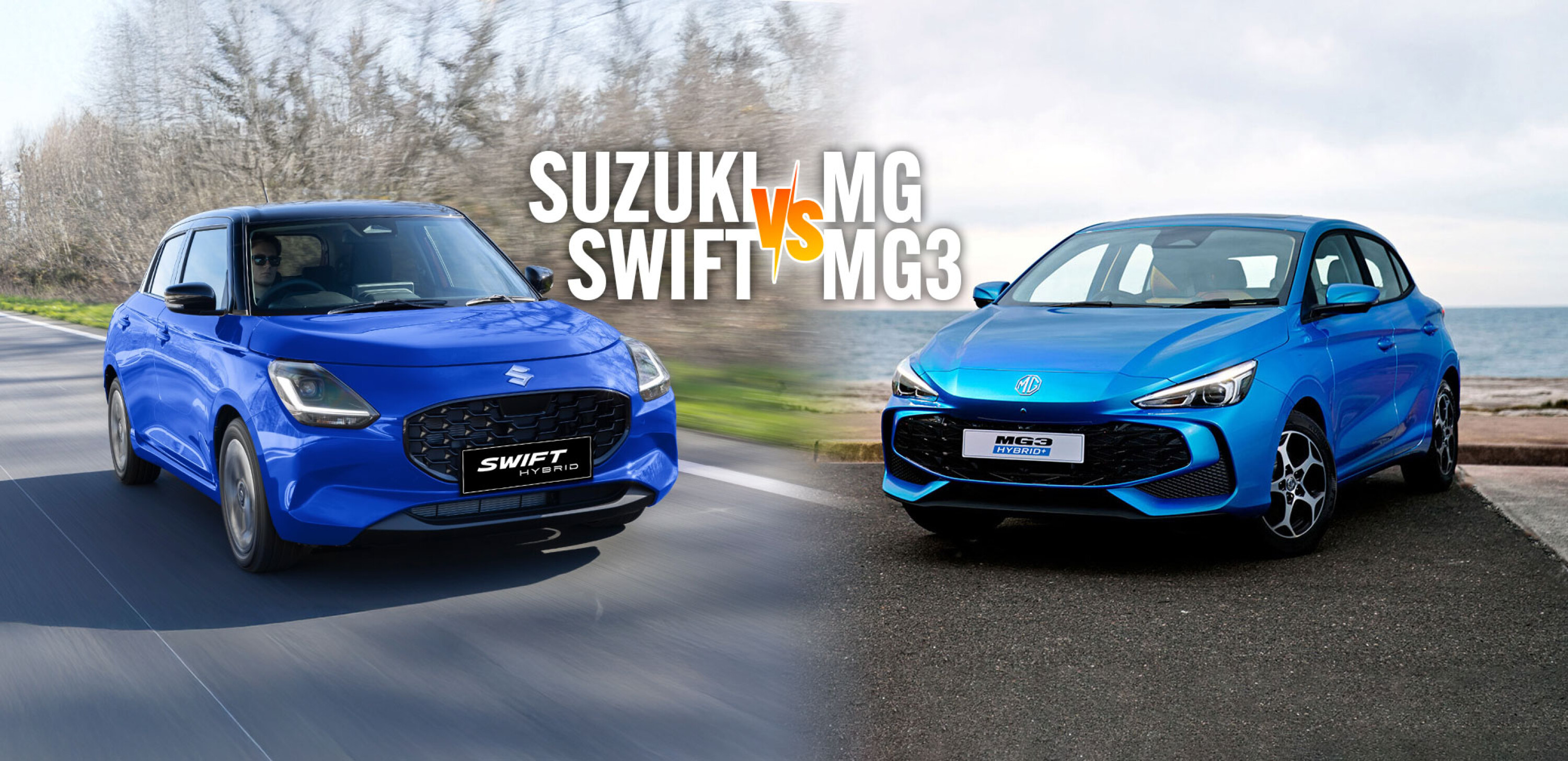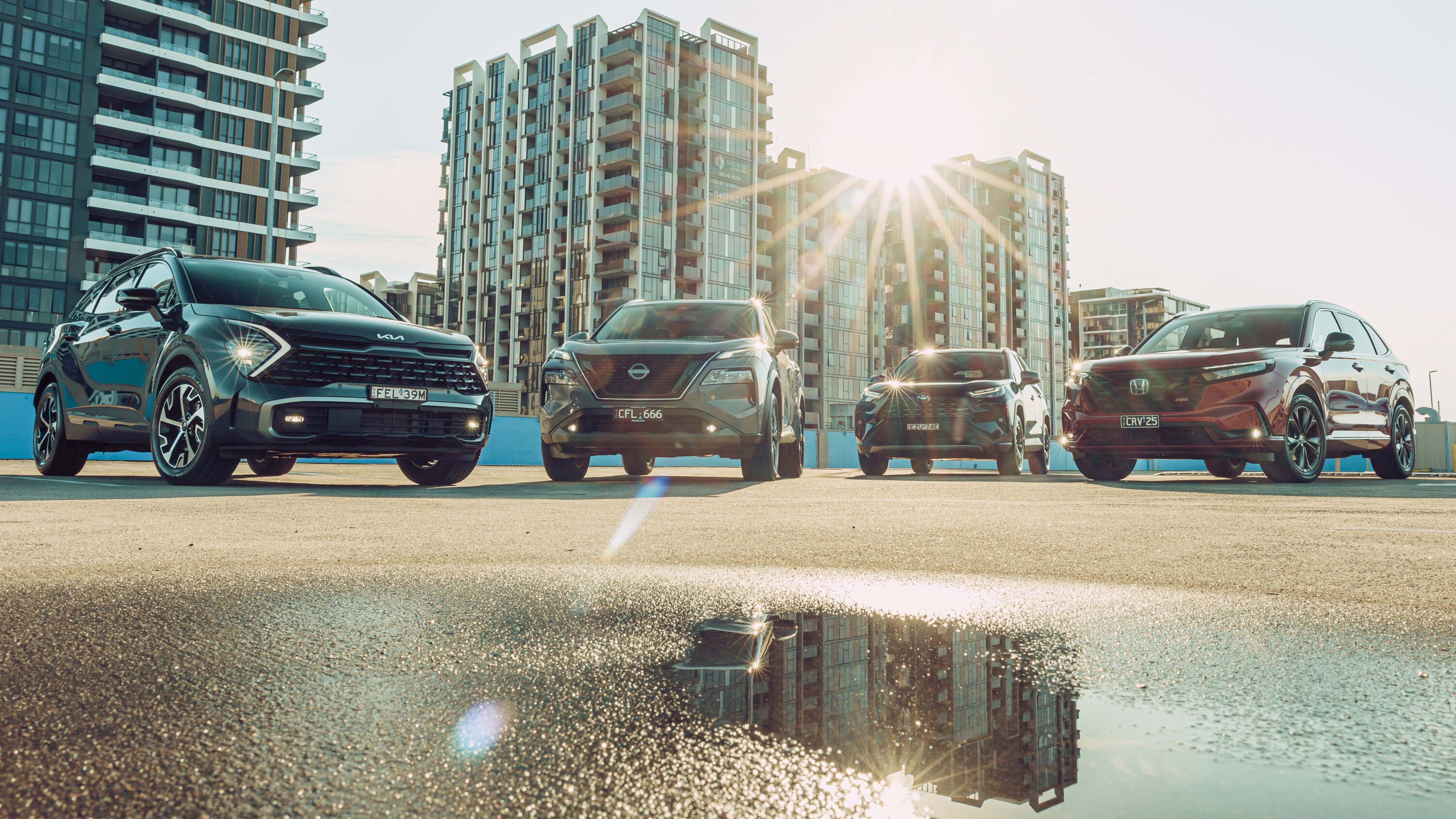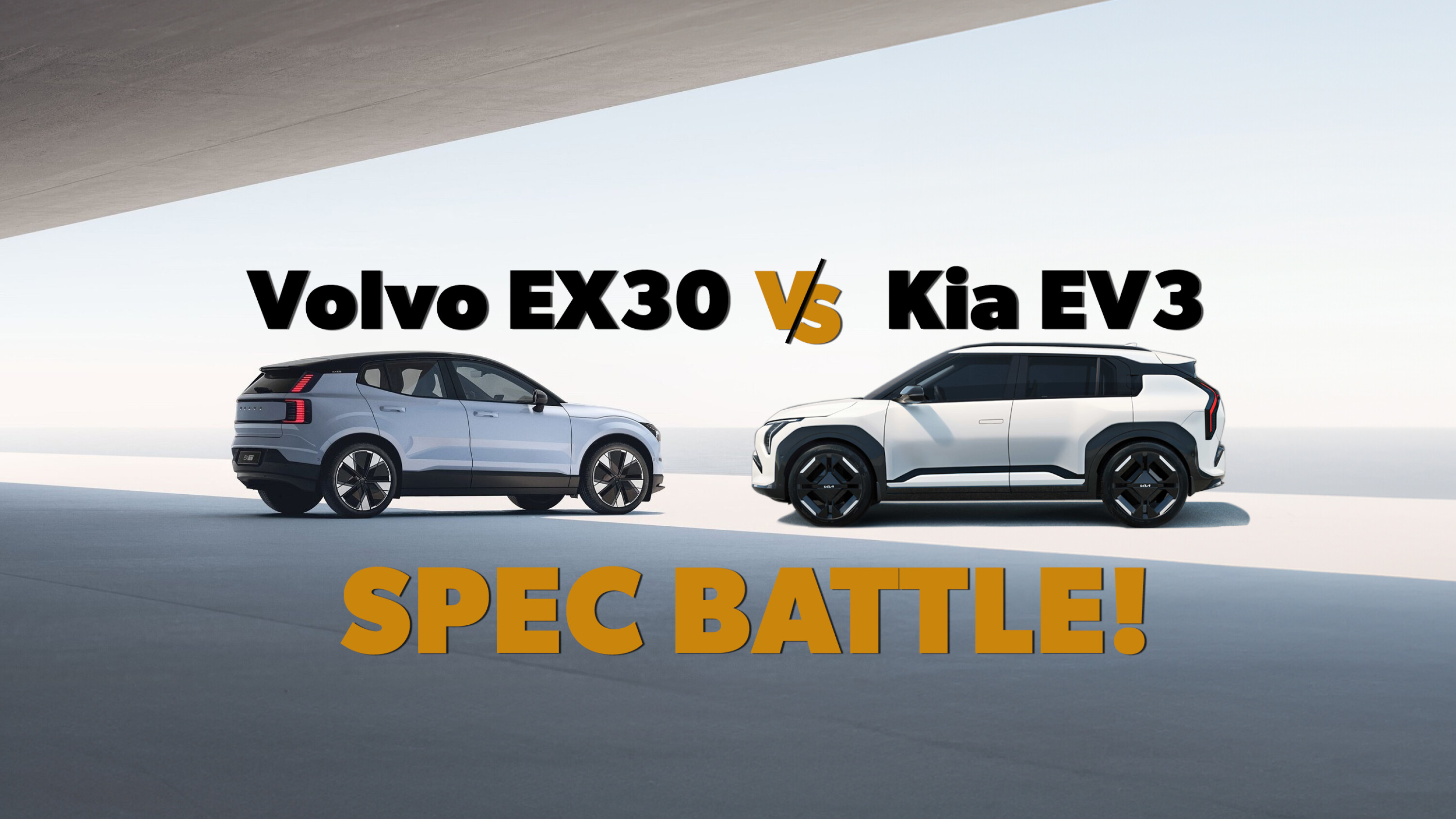Got a big family? Here are five seven-seat SUVs designed to move you.
First published in the September 2015 issue of Wheels magazine, Australia’s most experienced and most trusted car magazine since 1953.
Can’t wait to see the final scores? Jump to the verdict now.
THE realisation hits at the exact moment I lose the feeling in my fingers; we’re admiring a Kia. At first I dismiss our migration towards the Korean SUV as a need for communal warmth, given that it’s dawn and we’re ankle deep in snow, but the furtive glances at the Kia’s chiselled grille and Batman-esque tail-lights betray the real reason. We’re here because the Sorento looks fantastic.
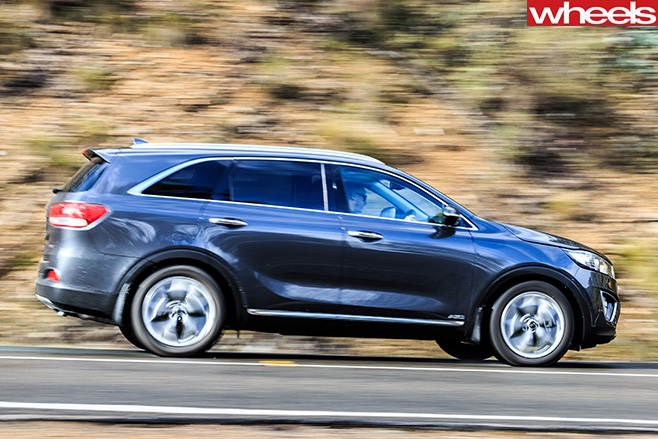
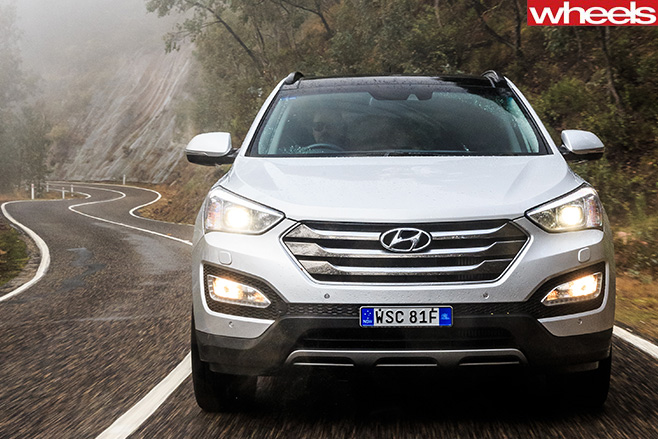
The people’s favourite
Doing so means trumping the most popular people-lugger here, Toyota’s Kluger. In the sales race, the Kluger is a behemoth, its 6780 sales in the first half of this year monstering this group’s next-biggest seller, Ford’s evergreen Territory, by more than 2000 units.
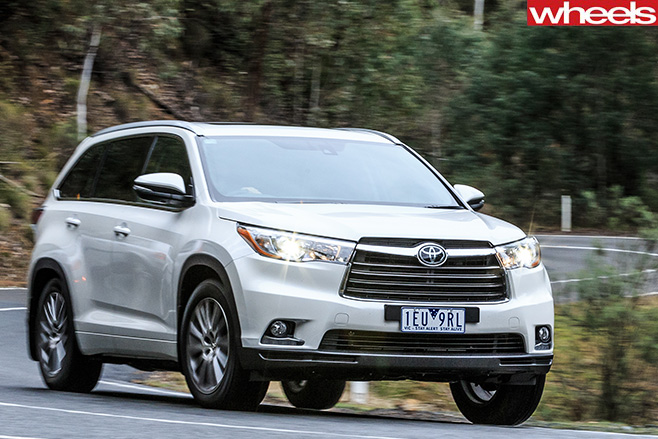
Grande spec adds a suite of equipment extras including adaptive cruise, lane departure, blind spot detection, LED headlights, bigger 19-inch wheels and a nine-inch roof-mounted entertainment system. This might sound impressive in isolation, but for a car nudging $70K the Kluger only matches what the two Koreans offer as standard at more than 10 grand less.
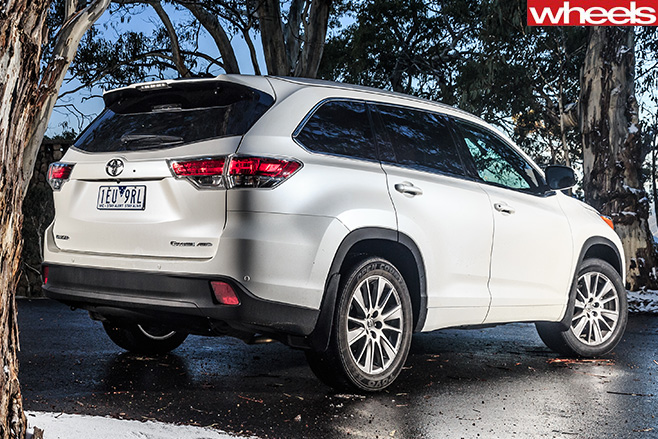
Hybrid philosophy
That’s a caveat that can’t be applied to the Nissan. Like the Kluger, the Pathfinder is now made in America but is the only SUV here without a local suspension tune. It also represents a drastic change in philosophy.
Where the previous Pathfinder was based on a ladder chassis and boasted off-road credibility, this new model is now a fully fledged urban SUV with monocoque construction, petrol-only engines and even the option of front-drive variants. Also worth mentioning is that, while the Pathfinder feels new on Aussie roads, this ‘new’ generation has been on sale in the US since 2013.
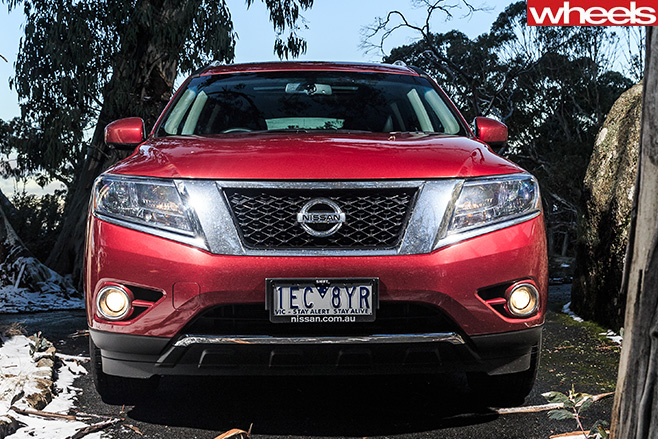
Traditional Aussie
All of this means the Pathfinder is a showcase of futuristic tech and it makes sliding into the Territory something of a time warp with its dated interior and ageing 2.7-litre V6 diesel lump.
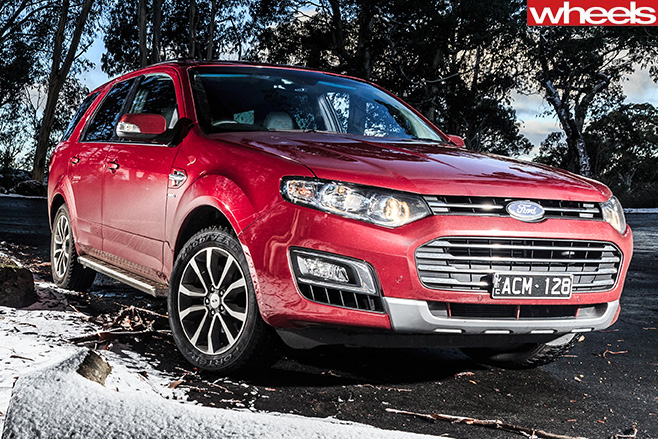
Also front and centre is the Territory’s undeniable Aussie DNA. The first (and still the only) SUV to win Wheels COTY, the Territory is renowned for its crisp dynamics and superb body control.
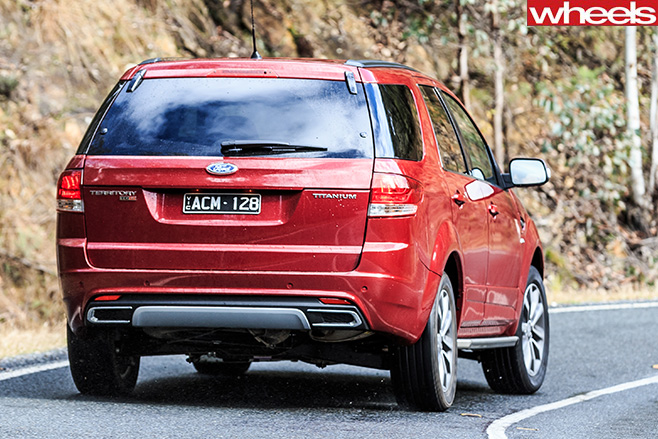
Power to move you
If only the engine was so convincing. The 2.7-litre turbo-diesel is frustratingly laggy from standstill and not what you’d call rapid on the move, either, with an 80-120km/h time that’s nearly a second slower than the other diesels here. Tall gearing engineered for efficiency rather than performance magnifies the oiler’s laziness and means the Territory often feels a gear too high on tight, twisty roads. Add in a noise that’s clattery and unrefined and the Land Rover-sourced diesel is the weakest of the trio in this test.
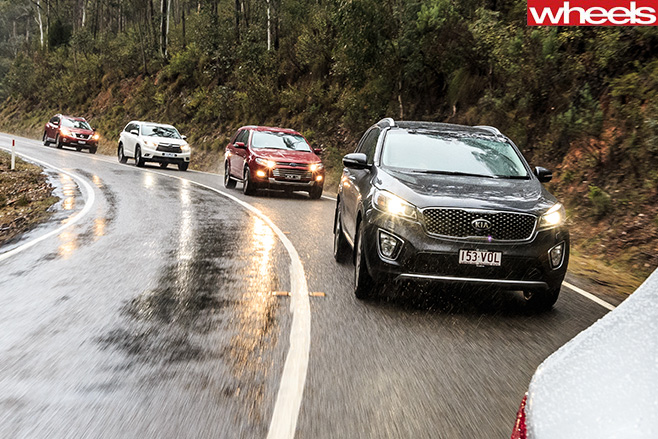
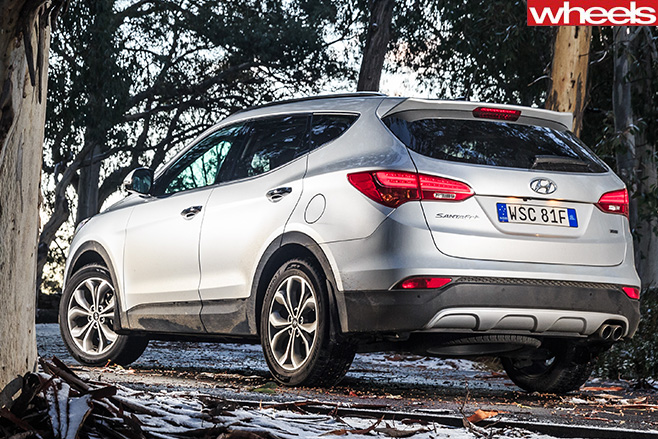
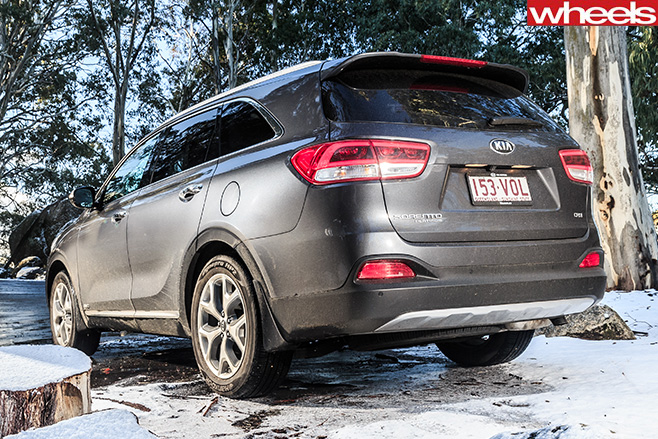
Yet, as sporty as it is, even the Santa Fe is decimated by the Kluger in a straight line. The beefy Toyota is the quickest car here thanks to its muscular 201kW/337Nm V6, which is wonderfully linear and sounds good, too. But such petrol-powered performance comes at a price, literally, with the Kluger drinking 13.3L/100km on test while the frugal diesels sipped just 9.3 (Sorento), 9.4 (Santa Fe) and 10.4 (Territory).
Turn and turn about
In terms of dynamics, the Kluger stays true to traditional Toyota values, meaning safe, predictable and an overeager electronic nanny that intervenes before you can fully exploit the potential of either the chassis or the engine.
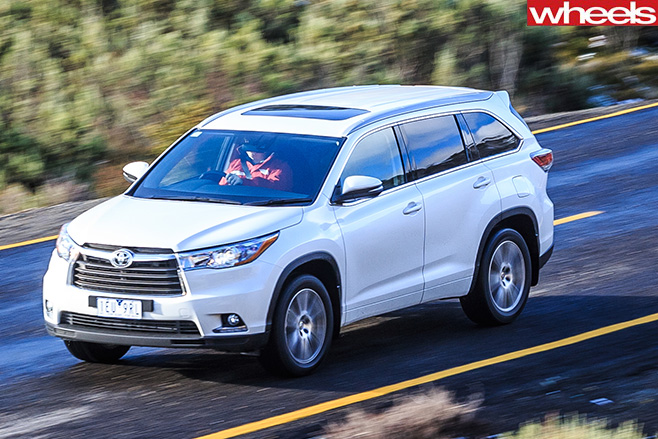
Sadly, the Pathfinder has no such saving grace. While the Nissan’s hybrid drivetrain is zingy, engaging and surprisingly quick (only three-tenths separate it and the Kluger over the quarter), things unravel when you throw its nose at a corner.
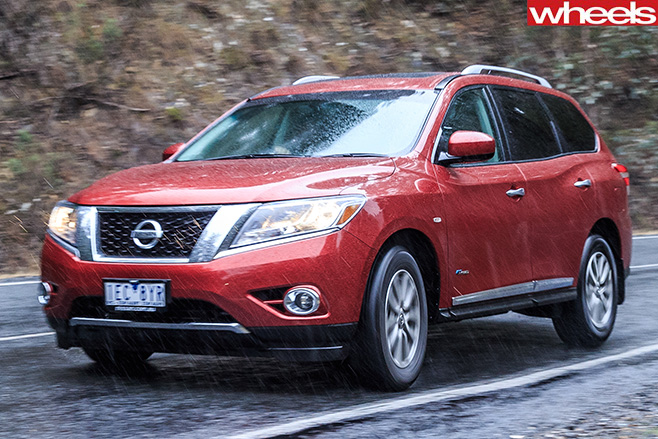
Brakes that struggle to contain the Hybrid’s power and 2073kg weight are another weakness and cement the Nissan’s place at the bottom of the dynamic pack.
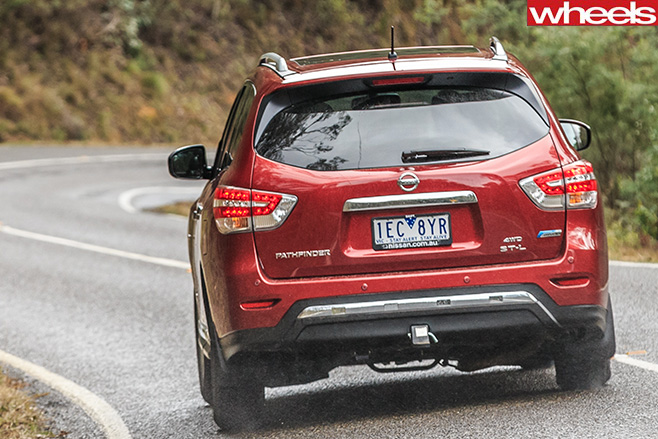
Our fuel figure of 12.1L/100km looks steep on paper, particularly against the thrifty diesels, but our test route’s heavy emphasis on country driving failed to exploit the Hybrid’s potential economy benefits. The Nissan’s petrol-electric tech is designed to shine in stop-start city traffic.
Inside dope
Where the Pathfinder does claw back some ground is the flexibility of its interior. Each car here boasts a 60/40 folding second row, but the Nissan’s one-touch design is the only one that conveniently flips up the bottom cushion to increase the distance that the middle row can slide forward. It’s a clever system and means the Nissan has the best access to the third row. There’s also plenty of space for third-row passengers, who are additionally spoilt with air vents, cupholders and, crucially, excellent vision.
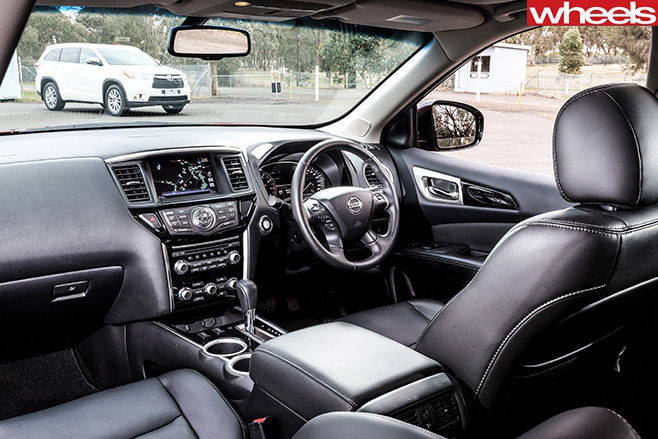
Things are decidedly more upmarket in the Hyundai and Kia. Both boast premium-feel interiors with comfortable leather seats, one-touch third-row access and a middle bench with 40/20/40 configurability. They also bristle with an armoury of standard equipment: reversing camera, electric tailgate, panoramic roof, lane assist, front and rear parking sensors, auto lights, LED running lights, cruise control, heated seats, sat-nav and auto wipers.
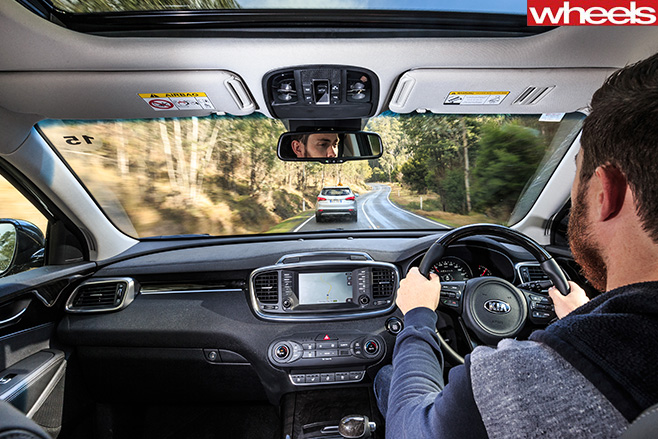
Second-row passengers in both Koreans have the luxury of heated seats, but the Kia’s lower window line means it’s the stronger choice for those who plan on lugging passengers in the back. The Hyundai may have comfortable seats and air vents with fan control back there, but its third-row visibility is atrocious.
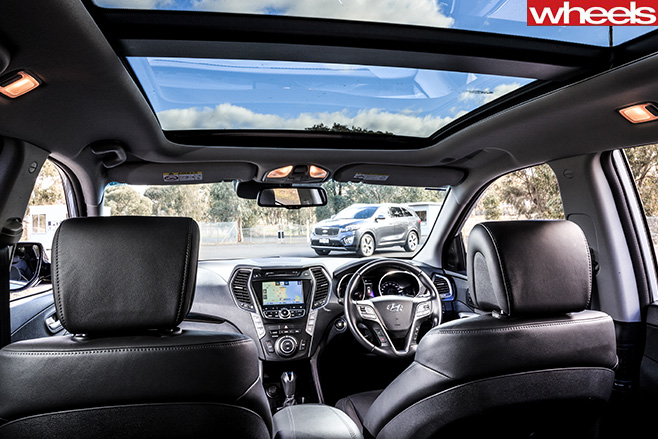
It’s inside where the Territory betrays its age most. Mismatched, scratchy plastics dominate an interior that even in this range-topping Titanium spec feels meanly equipped. Like the Nissan, there’s no electric tailgate, and the Ford has none of the surprise-and-delight features found in the Sorento, Santa Fe and Kluger, like blind spot detection, lane assist, heated seats or glass roof. The steering wheel buttons don’t illuminate at night.
So, which pleased us most?
Sitting still, the Territory therefore lacks the showroom sizzle of its competition, a negative that could cause buyers to walk away from what remains a truly great Australian road car. With excellent seats, a spacious second row big enough for three adults, superb vision and supple ride, the Territory’s still the best grand tourer of this group.
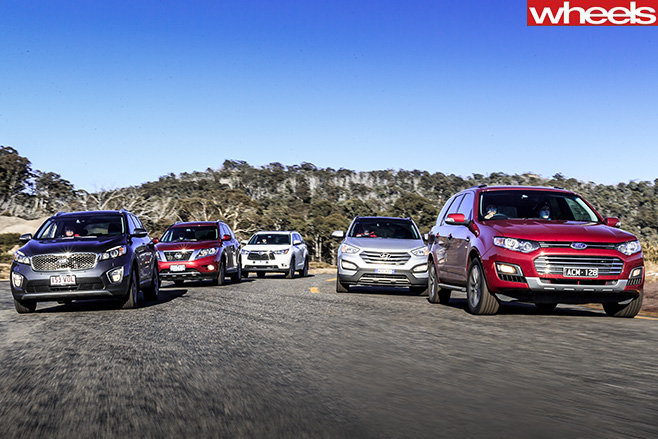
There are faults, though. Despite its space and equipment, the Kluger’s interior design is heavy-handed and its execution also lacks finesse. Compared to the Sorento’s premium Euro-inspired interior, the Kluger’s cabin feels like an economy car dressed in electronic tinsel. A prime example is the Grande’s chunky roof-mounted DVD system, which feels cheap and is mounted so low that middle passengers are inclined to hit their heads.
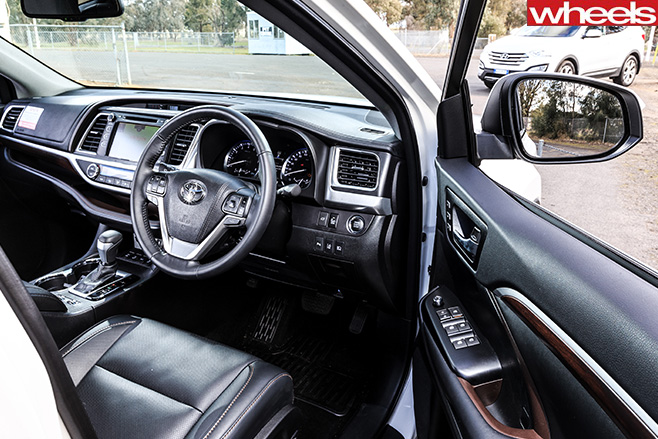
It’s a frustrating result for the Nissan given that the Hybrid does hold real appeal. Its front seats are supportive and comfortable, vision for front and second-row passengers is excellent, and for a car built to carry seven it has the best third-row access. Sticky Continental rubber and a drivetrain that promises efficient city driving and is responsive, seamless and dynamic are other strengths. It’s just a shame the Pathfinder’s execution is so hit and miss. Compared to the polished, all-round ability of the Koreans, the Pathfinder feels half-baked. And in this company, that doesn’t cut it.
Separating the Territory and Santa Fe is harder. On paper the Korean car has the edge thanks to its equipment, efficiency, four-year/unlimited-kilometre warranty and $53,240 price tag, which is $3500 less than the Ford’s. Its sporting focus and sharp dynamics also impart an unexpected sense of fun. But if the Santa Fe is an SUV that focuses on the driver, the Territory is a car for everybody, a grand tourer capable of hauling five adults in comfort.
There are faults with the Territory. The interior plastics are truly dismal, the diesel is agricultural and the third row is clumsy and really only suitable for occasional use. A question mark also hangs over the value of the range-topping Titanium, which for a $6000 premium over the mid-spec TS offers only negligible gains such as leather, chrome trim, sidesteps and a roof-mounted entertainment system. The cheaper $50,490 TS AWD diesel or $42,240 rear-drive TS petrol are better buys.
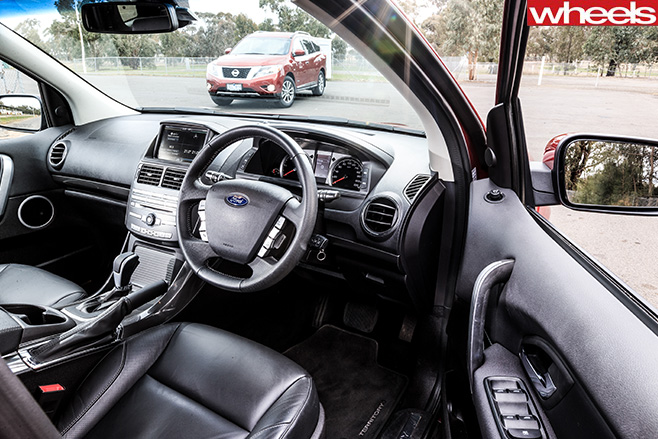
Hotter Hyundai
IF YOU want a Santa Fe with an even sportier feel, Hyundai has you covered. A harder, tauter, more athletic SR variant was launched last month, boasting H&R performance springs and bigger (340mm front, 302mm rear) Brembo brakes. It also rides on unique OZ Racing wheels wrapped with stickier Michelin Latitude tyres, but power remains unchanged at 145kW/436Nm. More performance equals more cash, with the SR costing $59,990.
Edgy replacement
THE SUV tipped to replace Territory at the end of 2016 is the Edge, which debuted in North America this year.
Touted as Ford’s most advanced SUV to date, it shares underpinnings with the new Mondeo and bristles with tech features including front and rear cameras, self-parking capability and adaptive steering.
A glaring difference is the Edge only seats five, so those wanting a third row will need to look at the new Ranger-based Everest (see First Drive this issue). A stretched seven-seat Edge does exist, but Ford says it is strictly a China-only variant. For now.
Still being debated is whether Ford will rebadge the Edge as a Territory given the name’s local heritage and reputation, or start afresh.
Yank tanked
IN NEWS smacking of irony, Nissan has axed production of the American-made Pathfinder Hybrid for the US market due to lacklustre demand. So does this mean the Hybrid will get bonked on the head here as well? Absolutely not, says Nissan Australia. Hybrid production will continue unchanged for overseas markets and Nissan Oz says it remains a core part of its Pathfinder line-up. Currently the Hybrid makes up 6.5 percent of local Pathfinder sales.
Verdict
 KIA SORENTO PLATINUM
KIA SORENTO PLATINUM
Price as tested: $56,585 *Includes: Premium paint ($595)
NCAP rating: 5 stars (Aus)
Fuel economy: 9.3L/100km (test average)
Acceleration: 0-100km/h: 9.5sec (tested)
Plus: Handsome design; interior ambiance & equipment; punchy diesel; warranty
Minus: Second-row vision; body roll when pushed hard
Verdict: 8.0/10
 FORD TERRITORY TITANIUM AWD
FORD TERRITORY TITANIUM AWD
Price as tested: $57,240 *Includes: Prestige paint ($500)
NCAP rating: 5 stars (Aus)
Fuel economy: 10.4L/100km (test average)
Acceleration: 0-100km/h: 10.0sec (tested)
Plus: Handling & agility; superb body control/ride; seats; Aussie DNA
Minus: Interior plastics; compromised third-row; agricultural diesel
Verdict: 7.0/10
 HYUNDAI SANTA FE HIGHLANDER
HYUNDAI SANTA FE HIGHLANDER
Price as tested: $53,835 *Includes: Metallic paint ($595)
NCAP rating: 5 stars (Aus)
Fuel economy: 9.4L/100km (test average)
Acceleration: 0-100km/h: 9.2sec (tested)
Plus: Strong drivetrain; hot-hatch handling; comfortable, well-equipped interior
Minus: Firm, uncompromising ride; interior a step behind Sorento
Verdict: 6.5/10
 TOYOTA KLUGER GRANDE
TOYOTA KLUGER GRANDE
Price as tested: $67,680 *Includes: Metallic paint ($550)
NCAP rating: 5 stars (Aus)
Fuel economy: 13.3L/100km (test average)
Acceleration: 0-100km/h: 7.9sec (tested)
Plus: Creamy-smooth V6; local steering and suspension; interior space
Minus: Design that lacks elegance; feels American; V6 thirst
Verdict: 5.5/10
 NISSAN PATHFINDER HYBRID ST-L
NISSAN PATHFINDER HYBRID ST-L
Price as tested: $57,985 *Includes: Metallic paint ($495)
NCAP rating: 5 stars (Aus)
Fuel economy: 12.1L/100km (test average)
Acceleration: 0-100km/h: 8.0sec (tested)
Plus: Zingy drivetrain; smooth, intuitive CVT; clever design of second and third rows
Minus: Anaesthetised steering; sloppy body control; interior feels cheap
Verdict: 5.0/10




